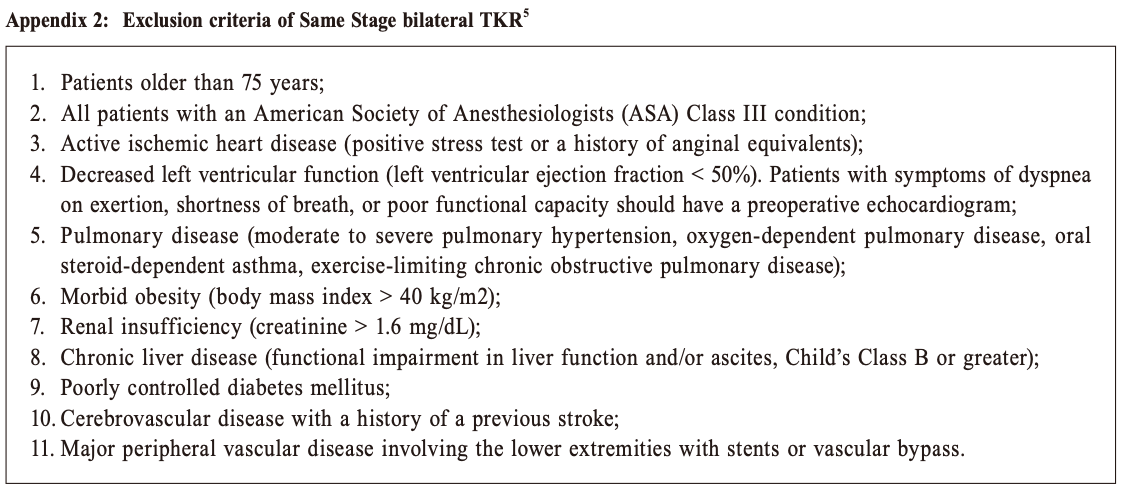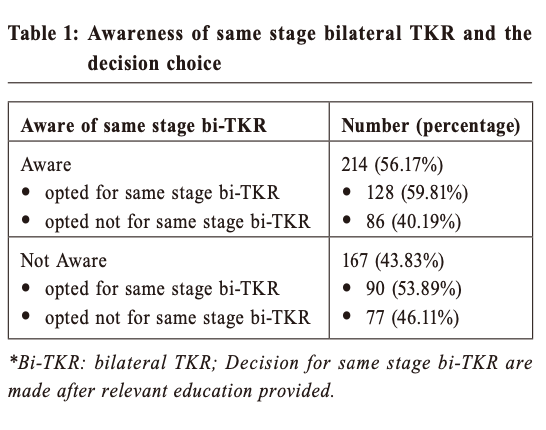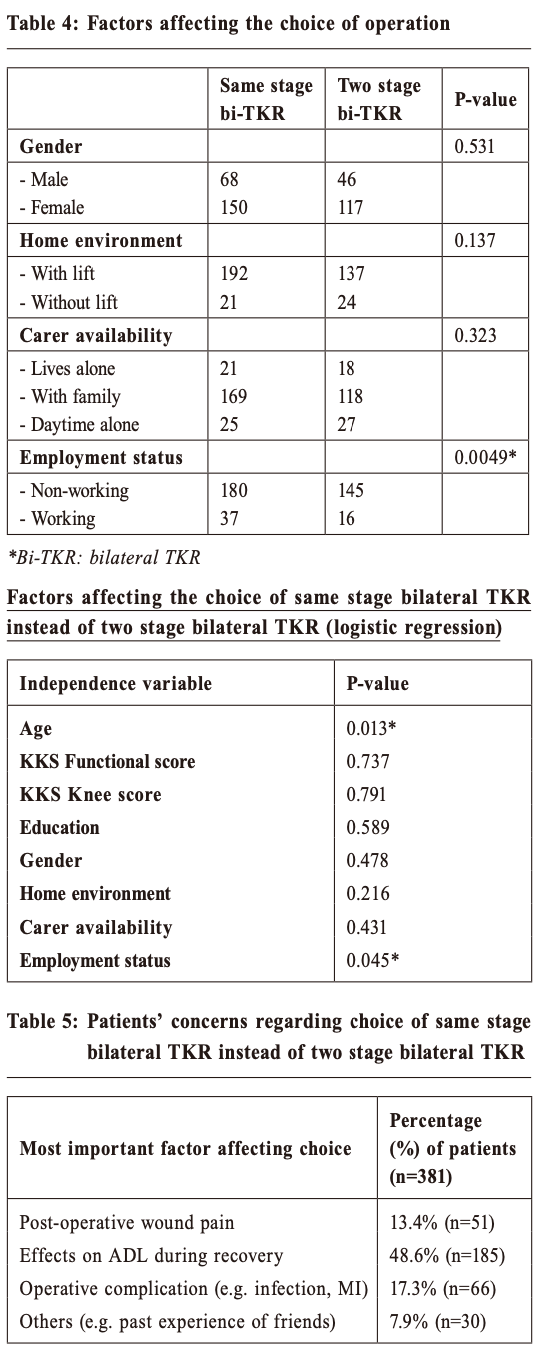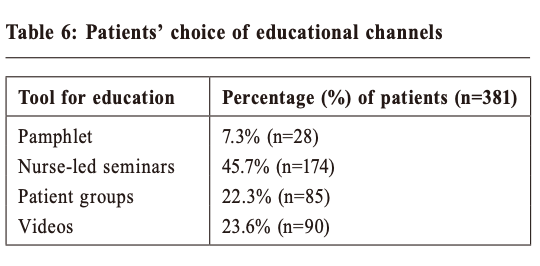
|
December 2019,Volume 41, No.4
|
Original Article
|
The current knowledge and acceptance of same stage bilateral knee replacement among prospective joint replacement candidates in a Hong Kong local joint centreLawrence CM Lau 劉振民,Ellis LF Wong 王洛輝,Yuk-wah Hung 洪煜華,Vikki WS Chu 朱詠珊, Carson KB Kwok 郭嘉邦,Jason CH Fan 范智豪 HK Pract 2019;41: 91-97 SummaryObjective: Keywords: Bilateral total knee replacement; patient education; survey; acceptance; knowledge transfer 摘要目的:全球膝骨骨性關節炎的發病率不斷升高。雖然手術的危險和益處仍有爭議,但在小心挑選的病人中,同時雙側膝
關節置換手術(SSBKR)是一個可行的治療方案。現時尚無發達國家的病人對於此項手術之認知和接受程度方面的研究資料。本研究的目的是檢視目前病人對此手術(SSBKR)的
知識和觀感,以幫助日後為病人提供教育。
關鍵字:雙側全膝關節置換,病人教育,調查研究,接受,知識傳遞。 IntroductionBackgroundKnee osteoarthritis (OA knee) is increasing globally and total knee replacement (TKR) is a definitive treatment for OA knee.1,2 Approximately one third of TKR patients exhibit degenerative symptoms bilaterally. 1 These patients can choose between (1) a same stage bilateral TKR (i.e. bilateral TKR during the same anaesthetic session) and (2) two stages bilateral TKR (i.e. TKR of each knee at two different anaesthetic sessions, also known as staged bilateral TKR). 1,3 In general, patients having same stage bilateral TKR have shorter total acute care stays and total rehabilitation stays and more importantly enjoy bilateral pain-free knees at earlier time point 4 (see Appendix 1 Pros and Cons of SSBKR). However, same stage bilateral TKR is also associated with greater haemodynamic changes and therefore stringent exclusion criteria exists to safeguard patients, with young and fit one as the ideal candidates 5 (see Appendix 2 Exclusion criteria of SSBKR). 
 Controversies exist regarding these two choices with two meta-analyses of retrospective studies in 2013 drawing similar conclusion that same stage bilateral TKR may be associated with lower risk of deep infection and revision rate, similar risks of neurological complications, deep-vein thrombosis, cardiac complications and superficial infection but higher rates of mortality, pulmonary embolism and blood transfusion.1,6 These results were suggested to interpret with cautions given the retrospective study design and selection bias in patients for two stage bilateral TKR.1,6 Later studies with larger sample sizes reported these two choices are associated with similar morbidity and mortality with similar risk of aseptic or septic failure, death within 90 days, or major medical complications (acute myocardial infarction, deep-vein thrombosis, or stroke).7-10 On the other hand, studies reported that same stage bilateral TKR is associated with less postoperative stiffness, comparable range of movement, the ability to return to work and to perform activities of daily living.11,12 No matter which of these choices is chosen, treatment goal is to achieve safe surgery with patient satisfaction, with the latter is highly influenced by patient’s preoperative expectation.13-16 Despite same stage bilateral TKR has been in place internationally for some period1,11,17-21, the knowledge and attitudes towards same stage bilateral TKR in patient are lacking in existing literature. These two components are crucial in attributing to patient’s expectation of same stage bilateral TKR. If their pre-existing knowledge and acceptance are significantly different from the surgery’s inherent complex risks and benefits and this difference is not addressed pre-operatively, the surgery would not meet their expectation and lead to patient dissatisfaction and poor outcome. Here we investigate Hong Kong patient as a proxy for other patients from other modern cities or developed countries. ObjectivesThis study is designed to investigate the proportion of patients who were aware of and accepted same stage bilateral TKR as primary outcome. Secondary outcomes were about concerns affecting patients’ choice of same stage or two stages TKR and their preferred medium of education. Using data collected from this study, pre-operative education on same stage bilateral TKR can be modified and future resource planning regarding same stage bilateral TKR can be modified based on patients’ acceptance. MethodsStudy designThis was a cross-sectional survey carried out from January 2016 to December 2016 with design following STROBE checklist. Patients with knee osteoarthritis referred to Alice Ho Miu Ling Nethersole Hospital (AHNH-NTEC) Joint Center Outpatient Clinic for consideration of total knee replacement were invited to answer a standardised questionnaire on a voluntary basis. Patients who were mentally incompetent and those who had prior history of TKR were excluded. One-to-one interviews by our subspecialised joint nurse or research staff were conducted to collect all the data. Before the study began, we provided a set of standard information to the nurse and the research staff and trained them to conduct the interview such that they provided the same information to patient with consistent interview process. Knowledge on same stage bilateral TKR was provided stepwise during the course of interview to facilitate patient making informed choice. QuestionnaireA structured questionnaire was developed by a team of orthopedic surgeons who subspecialised in Joint Reconstruction. The questionnaire was available in traditional Chinese and included three parts. The first part included demographic information, occupation, characteristics of home environment, and activity-of-daily-living (ADL). The second part included questions determining the awareness of same stage bilateral TKR, channels where one obtain clinical information, whether one would opt for same stage bilateral TKR and factors affecting the choice of operation. The third part included a list of channels for pre-operative educations (including pamphlets, videos, nurse-led seminars and patient support groups) for rating by the participants. Sample sizeTo estimate the proportions of participant responses to the questionnaire, we reviewed our pilot data and estimated that around 50% patient reported positive understanding of bilateral same stage TKR. For 95% confidence level with an expected true proportion of 50% and 5% margin of error, a sample size of 380 was calculated using the formula: N=Z2p(1-p)/C2 (N=sample size, Z=Z value, p=population variance, C=margin of error). Statistical analysesStatistical analyses were performed using SPSS 13.0. The relative effects of parametric data on the choice of operation (age, KKS function score, KKS knee score) were studied by Independent sample t-test. The relative effects of categorical data (gender, home environment, ADL demand, carer availability, employment status) were studied using Pearson Chi-square test. The critical level of statistical significance was set at 0.05. Ethics approvalThis study has been approved by the Joint Chinese University of Hong Kong and New Territory East Cluster Clinical Research Ethics Committee (CREC Ref No: 2018–136). ResultsDemographic dataA total of 381 consecutive patients were interviewed with questionnaires completed during the study period, which corresponded to a response rate of 100%. The average age of the study population was 66.9 +/- 7.1 years. Regarding the awareness of same stage bilateral TKR, 214 patients (56.2%) were aware of the option, while 167 patients (43.8%) were unaware of the option. As for the choice of operation, 218 patients (57.2%) would opt for same stage bilateral TKR, while 163 patients (42.8%) would opt for two stage bilateral TKR after they received relevant knowledge (Table 1).  For patients who opted for same stage bilateral TKR, the mean age was 65.9 +/- 6.9 years; the mean KKS Functional score was 55.2; the mean KKS knee score was 51.67 (Table 2). Regarding the educational level, 37 patients (17.0%) did not receive formal education; 100 patients (45.9%) received primary education; 72 patients (33.2%) received secondary education; 8 patients (3.7%) patients received tertiary education; 1 patient did not report his educational background (Table 2 and 3).  For patients who opted for two stage bilateral TKR, the mean age was 68.3 +/- 7.1 years; the mean KKS Functional score was 56.4; the mean KKS Knee score was 51.9 (Table 1) . Regarding the educational level, 31 patients (19.0%) did not receive formal education; 80 patients (49.1%) received primary education; 41 patients (25.2%) received secondary education; 7 patients (4.3%) patients received tertiary education; 4 patients did not report their educational background (Table 2 and 3). Age (p=0.013) and employment status (p=0.045) were significant factors associated with SSBKR (Table 4). Concerns affecting the choice of operationRegarding concerns affecting the choice of operation, 185 patients (48.6%) considered the effects on ADL during recovery after same stage bilateral TKR or two stage bilateral TKR as the most important factor. While 66 patients (17.3%) considered operative complications, 51 patients (13.4%) considered post-operative wound pain, 30 patients (7.9%) considered other factors (e.g. experience of friends) as the most important factor affecting their choices respectively (Table 5).  Educational tool Regarding the most useful pre-operative educational tool, 174 patients (45.7%) found nurse Table led seminars most useful, whereas 85 patients (22.3%) found patient groups, and 90 patients (23.6%) found educational videos most useful respectively. Only 28 patients (7.3%) found pamphlet most useful. 4 patients did not indicate any preferences (Table 6).  DiscussionSevere knee osteoarthritis requiring knee replacement is getting more common amongst our aging population. With the advancements in peri-operative care for joint replacement surgery, some patients with severe bilateral knee pain may benefit from same stage bilateral TKR after careful selection. 1,17,19,20 Given the multifaceted benefits and risks to be balanced in same stage bilateral TKR, a shared decision making with patient is fundamental to the success of surgery by meeting their expectations. 14-16 Patient’s pre-existing beliefs, knowledge and acceptance shapes their expectations after TKR and it is therefore necessary to find out these specific components from patients. Our study revealed several important findings. First, less than half of the respondents (43.8%) were aware of the availability of same stage bilateral TKR initially. After information about this option was provided and discussed, 57.2% of patients reported that they would opt for same stage bilateral TKR if it was given to them as an option. This suggests that patients in general do not have relevant information on same stage bilateral TKR but this information is crucial for them to determine their final surgical decision. Notably, this study was performed in Hong Kong where the mobile subscriber penetration rate (259.9%) and household broadband penetration rate (93.2%) are amongst the highest in the world. 22,23 And at the same time, the general population are well educated with free education and these suggested that patients and their relatives might possess high degree of information accessibility and fair interpretation capability, as comparable to other international developed cities and countries. We hypothesise this lack of awareness about same stage bilateral TKR is due to subspecialised nature of operation and limited availability of online information. Nevertheless, it is beyond the power of this study to clarify this. The final surgical choice depends on patient preference and a mutual understanding of the surgical journey and treatment expectations, which in turn affects health care system resource planning if certain beliefs are prevalent. 13-16,24 The employment status of patients had significant effect on the choice, with patients at working age more likely to opt for same stage bilateral TKR (p = 0.013) (Table 4). Regarding the primary concerns of patients, it was found that the effects on ADL during recovery was of utmost importance, with 58.5% of our patients rating it as the most important factor affecting their choice (Table 2). This implies that for patients in a highly commercialised city like Hong Kong, a shorter course of post-operative recovery and duration of hospitalisation were the major factors affecting their preference, especially for the working population and this result is likely applicable to other modern cities as well. Pre-operative education was important to guide patient in making an informed decision. Our study found that nurse-led seminars, post-operative videos showing the course of rehabilitation and functional outcomes, patient support groups were well-accepted channels for health education. Nurse-led seminars were the most popular channel, with 41.4% of patients rated it as the most effective. However, pamphlet was found to be the least popular channel for health education, with only 6.9% of patients rated it as most effective. The phenomenon was likely to be related to the interactions with healthcare professionals during seminars, and patients could have their concerns directly addressed. Based on our study result, patient sharing groups and educational videos were introduced in our unit preoperation education program in 2017. The percentage of same-stage bilateral knee replacement among all knee replacements performed increased from 29.1% in 2016 to 37.5% in 2017 in our unit. LimitationsThis study is limited by its potential sampling bias of only interviewing patients referred to AHNH Joint Centre for joint replacement for convenience sampling. Another limitation of our study is small sample size of 381 participants only. Nonetheless, our study was conducted through one to one interview and thus we achieved 100% response rate of these 381 consecutive patients. AHNH-NTEC Joint Centre covers 17.5% of total Hong Kong population and the Joint Centre constantly receives patient referrals from other parts of Hong Kong due to shorter waiting time. The result of this study likely represents around one-fifth of Hong Kong population requiring TKR. In the future, multi-centre studies can be conducted to recruit representative samples from various joint centres to assess any difference in pre-existing knowledge and acceptance of same stage bilateral TKR in different population. Nevertheless, this is the first study to evaluate the awareness and knowledge about bilateral same stage total knee replacement in a modernised city like Hong Kong. It provides important information that can be applied in setting up joint replacement centre and in designing educational material for population.  One of the unstudied parameters that would potentially affect the choice is the patient's self-perceived medical fitness. In our practice, we allow the option of same stage bilateral TKR if they are younger than 75 year-old and ASA <3 but the final decision is made after anaesthetist review. Some of the anaesthetic concern may not be apparent in patients’ initial consultation if they did not undergo previous medical workup, causing discrepancy between their perceived and actual medical fitness. Therefore our study did not include patient's self-perceived medical fitness which is difficult to quantify. From literature, same stage bilateral total knee replacement can be further classified into two subtypes: simultaneous (two surgical teams simultaneous performed bilateral TKR in same anaesthetic setting) and sequential (one surgical team performed sequential TKR on both knees one by one in same anaesthetic setting). 17 Nonetheless, this technical difference is not related to our focus in this paper. Thus, we simplified the topic to same stage bilateral TKR. ConclusionA significant proportion of the patients are unaware of the availability of the option to have a same stage bilateral TKR. Primary care (physician, nurse clinics, education videos) providing patients and their family preliminary knowledge of same stage bilateral TKR before their consultation with orthopaedics surgeons may facilitate them reaching a final shared decision making. A well designed pre-operative educational program can help to provide knowledge on their treatment options and address patients’ concern, which, in turn, can bridge patient’s expectation and reality of surgery. As a result, the management of bilateral knee osteoarthritis could be more effective as more patients could accept and benefit from same stage bilateral TKR. AcknowledgementWe would like to thank Ms Carman Ka Man Lo and Ms Siu Wan Wong for assisting data collection. DeclarationThe author has disclosed no conflicts of interest.
Lawrence CM Lau, MbChB (CUHK), MRCS (Ed)
Ellis LF Wong, MbChB (CUHK), MRCS (Ed)
Yuk-wah Hung, FHKCOS, FHKAM (orthopaedics surgery)
Vikki WS Chu, MPhil
Carson KB Kwok, FHKCOS, FHKAM (Orthopaedic surgery)
Jason CH Fan, FHKCOS, FHKAM (Orthopaedic surgery)
Correspondence to:Dr Lawrence CM Lau, Department of Orthopaedics and
Traumatology, Alice Ho Miu Ling Nethersole Hospital, MO Room, 2nd floor, Alice Ho Miu
Ling Nethersole Hospital, Tai Po, Hong Kong SAR.
References:
|
|